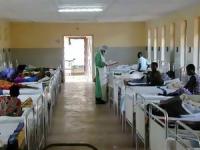-
Dust Bowl would devastate today’s crops: Study

A drought on the scale of the legendary Dust Bowl crisis of the 1930s would have similarly destructive effects on U.S. agriculture today, despite technological and agricultural advances, a new study finds. Additionally, warming temperatures could lead to crop losses at the scale of the Dust Bowl, even in normal precipitation years by the mid-twenty first century.
-
-
Health wearable devices pose new consumer and privacy risks
Watches, fitness bands, and so-called “smart” clothing, linked to apps and mobile devices, are part of a growing “connected-health” system in the U.S., promising to provide people with more efficient ways to manage their own health. These personal health wearable devices, which are used to monitor heart rates, sleep patterns, calories, and even stress levels, raise new privacy and security risks, according to a new report.
-
-
New math can help fight viral outbreaks
HIV … SARS … Ebola … H1N1 … Zika. The list of communicable global health threats seems ever growing, and frequently the limited resources available to fight these diseases must be picked up and redeployed — often haphazardly — as the next new threat emerges. But what if there were ways to wage a more effective war against all communicable diseases, using new combinations of proven complex sociological and statistical mathematic models to tell where an outbreak might occur, how it might spread and how best to fight it?
-
-
Biological emergences: Incremental progress not enough
While acknowledging some positive efforts over the past year by the White House and Congress, the bipartisan Blue Ribbon Study Panel on Biodefense says the incremental progress is not enough to defend against biological emergencies, let alone catastrophic events. The report, Biodefense Indicators – One Year Later, Events Outpacing Federal Efforts to Defend the Nation, states that while the biological threat is real and continues to grow, our nation remains woefully under-prepared for dangerous biological incidents.
-
-
Developing the National Livestock Readiness Program
The National Agricultural Biosecurity Center has received $331,118 from the Department of Homeland Security through its Basic Ordering Agreement with K-State to develop the National Livestock Readiness Program. The project, with its initial deliverables completed by September 2017, will provide a clearinghouse for planning, training, and knowledge products to help state and local entities prepare for transboundary livestock disease outbreaks.
-
-
Real-time online epidemic tracking tool relies on open data, collective intelligence

Until now, disease data and geographic information about the movement of an infection or disease as it evolves and spreads has been locked up in databases that are often out of people’s reach. Researchers have been left to rely on published information in research papers, which may be many months out of date, containing static visuals which show only a small part of the whole disease or infection threat. Now, researchers have developed Microreact, a free, real-time epidemic visualization and tracking platform that has been used to monitor outbreaks of Ebola, Zika, and antibiotic-resistant microbes.
-
-
Emergent BioSolutions to supply up to $1 billion of anthrax vaccine to the Strategic National Stockpile
Emergent BioSolutions signed follow-on contract with CDC valued at up to $911 million to supply to the Strategic National Stockpile (SNS) approximately 29.4 million doses of BioThrax through September 2021. BARDA issued notice of intent to separately procure approximately $100 million of BioThrax for the SNS over twenty-four months from contract award, which is expected in 1H 2017. These actions, together with the recently awarded BARDA contract for NuThrax, reflect the U.S. government’s intention to transition the stockpile of anthrax vaccines from BioThrax to NuThrax.
-
-
$19 million to develop drugs to treat victims of chemical weapons attacks
First used by the German military against Allied troops in the First World War and in subsequent wars including the Iran-Iraq conflict during the 1980s, chemical weapons were more recently used by the Assad regime in Syria and by ISIS in Iraq and Syria. The National Institutes of Health (NIH) has awarded Rutgers University a five-year grant for more than $19 million for research that would lead to the development of drugs to treat toxicity from chemical agents used in a terrorist attack.
-
-
Predicting disease outbreak in a hyper-connected world
At the first hints of a disease outbreak, epidemiologists, health care providers, policy makers, and scientists turn to sophisticated predictive models to determine how an illness is spreading and what should be done to minimize contagion. New research is upending the traditional modeling process, yielding predictions that are both simpler to calculate and more attuned to a hyper-connected world.
-
-
Common grass to help boost food security
Common Panic grasses could hold the secret to increasing the yields of cereal crops and help feed the world with increasing temperature extremes and a population of nearly ten billion people by 2050. The grasses have the potential to improve crop yields for staple foods such as wheat and rice by transplanting enzymes from Panic grasses.
-
-
Symptomless Ebola – questions need to be answered before the next outbreak
Scientists know that Ebola can cause anything from severe hemorrhagic fever to no symptoms at all (asymptomatic infections). What wasn’t known, until now, is the number of people who experienced asymptomatic infections during the 2013-2016 outbreak of Ebola in West Africa. While the new report of asymptomatic cases of Ebola virus infection is not unique, it does raise important questions that need to be answered. Over the last couple of years, governments and global public health agencies have increased resources to tackle these questions. Hopefully, we will be better equipped and prepared for the next outbreak.
-
-
Supercomputer simulations help develop new approach to tackle antibiotic resistance
Supercomputer simulations at the Department of Energy’s Oak Ridge National Laboratory have played a key role in discovering a new class of drug candidates that hold promise to combat antibiotic resistance. Researchers combined lab experiments with supercomputer modeling to identify molecules that boost antibiotics’ effect on disease-causing bacteria.
-
-
Changes required to fortify U.S. blood system against financial, biological threats
The U.S. blood system collects, tests, processes, and distributes the blood that is ultimately used in clinical practice. In 2013, more than 14 million units of blood were collected in the United States from about 15.2 million individuals, with 13.2 million units transfused. Medical advances have reduced the demand for blood in the United States, creating financial pressure on the nation’s blood collection centers and threatening their future survival.
-
-
Improving biosafety, biosecurity in West Africa
The Defense Threat Reduction Agency and United States Strategic Command Center for Combating Weapons of Mass Destruction (DTRA/SCC-WMD) have selected CH2M to lead efforts in West Africa to broaden its Cooperative Biological Engagement Program (CBEP) on the African continent and reduce the threat of infectious diseases. The CBEP, developed by the Department of Defense to address global health security issues, was used in 2014 to support international efforts to combat the Ebola virus outbreak and other threats to global health security.
-
-
Israel Red Cross affiliate building underground blood bank to ensure supply during crises
Magen David Adom, the Israeli affiliate of the Red Cross, is building an underground blood bank in order to secure the country’s blood supply in case of attacks or natural disasters. “With all blood transfusions stored in an underground space, the facility will ensure that they remain unharmed even when the building is under a massive barrage of missiles,” Magen David Adom director said. The terror organization Hezbollah has an estimated arsenal of over 130,000 rockets capable of firing at Israel — more than the combined amount of the twenty-seven non-U.S. NATO member states.
-
More headlines
The long view
Ransomware Attacks: Death Threats, Endangered Patients and Millions of Dollars in Damages
A ransomware attack on Change Healthcare, a company that processes 15 billion health care transactions annually and deals with 1 in 3 patient records in the United States, is continuing to cause massive disruptions nearly three weeks later. The incident, which started on February 21, has been called the “most significant cyberattack on the U.S. health care system” by the American Hospital Association. It is just the latest example of an increasing trend.
